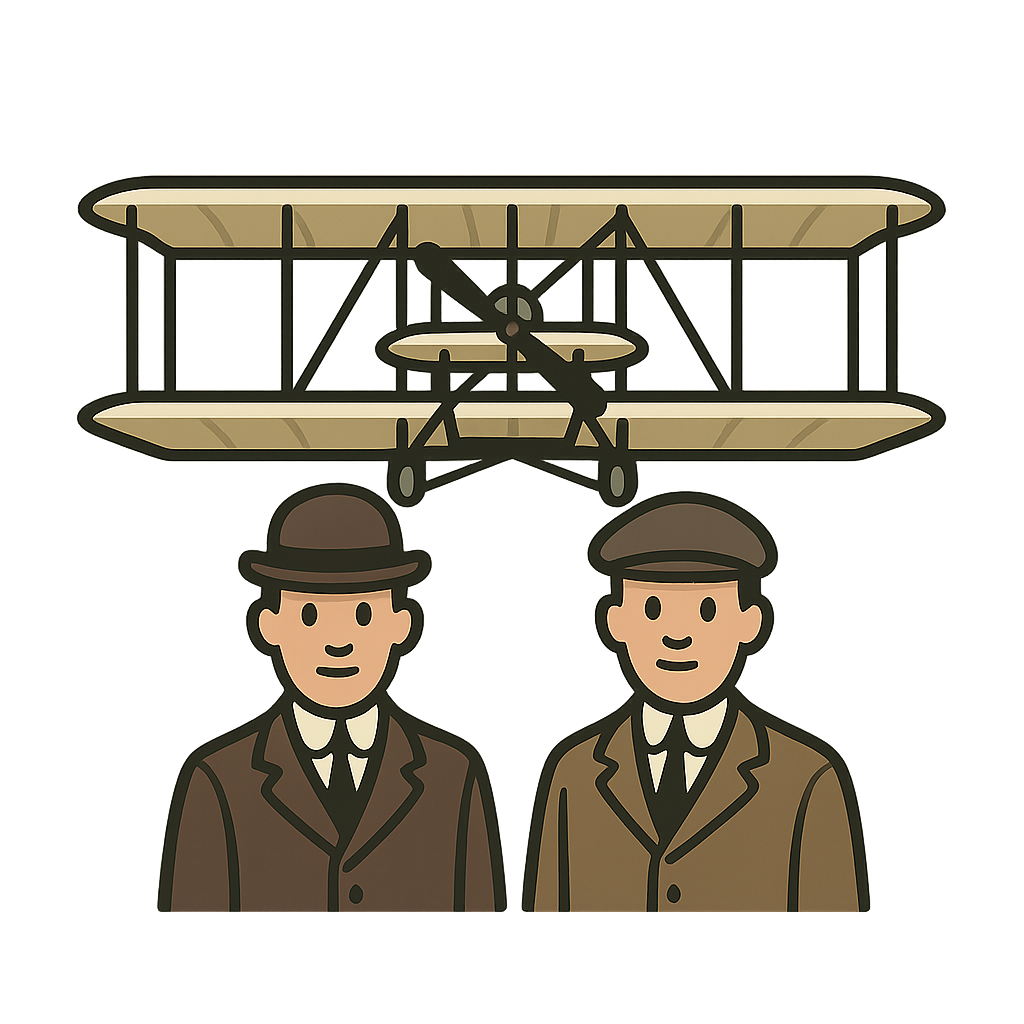Orville Wright and the First Flight
My name is Orville Wright, and my story is one that I shared with my best friend and brother, Wilbur. It all started not in a fancy laboratory, but in our little home in Dayton, Ohio. When we were boys, our father brought home a toy that changed our lives forever. It was made of cork, bamboo, and paper, with a rubber band to power its propeller. He tossed it into the air, and instead of falling, it flew up and touched the ceiling. We were amazed. That little toy helicopter planted a seed in our minds, a dream that we might one day build a machine that could carry a person through the sky. As we grew up, we opened our own bicycle shop. You might wonder what fixing bikes has to do with flying, but it taught us everything. We learned how gears and chains work together, how to build strong but lightweight frames, and most importantly, how to balance. Every time we tinkered with a bicycle, we were secretly thinking about wings and engines, imagining how we could use what we knew to conquer the air.
To make our dream a reality, we needed the perfect place to practice. We needed wind, and lots of it, to help lift our machines. We also needed a soft place to land, because we knew we would be crashing quite a bit. After studying weather charts, we found a little spot on the coast of North Carolina called Kitty Hawk. It was a lonely place with giant sand dunes and a wind that never seemed to stop blowing. It was perfect. For several years, we traveled there to test our ideas. We started with gliders, big kites that we could lie on and steer as the wind carried us. Our first attempts were not very successful. We would run along the sand, launch the glider, and often tumble right back down. It was frustrating work. The wind would rip the fabric, and the wooden frames would snap. But with every crash, we learned something new. We realized that just having wings wasn't enough; we had to be able to control them. One day, while twisting an empty bicycle tube box in our shop, Wilbur had a brilliant idea. We could twist, or warp, the wings of our glider just like a bird twists its feathers to turn and stay balanced. We called it 'wing-warping,' and it was the secret we had been looking for. It was our way to steer in the sky.
After years of testing gliders and building our own lightweight engine, we felt we were finally ready. The day was December 17, 1903. I remember it so clearly. The wind was fierce and cold, whipping sand into our faces. Most people would have stayed inside, but for us, that wind was an invitation. There were only a few people from the local life-saving station there to watch us. They probably thought we were crazy. Because we had worked on everything together, Wilbur and I flipped a coin to decide who would get to be the first pilot. I won. I climbed onto the lower wing of our machine, which we called the Wright Flyer, and lay flat on my stomach. Wilbur helped steady the wing as I got ready. The engine roared to life, sputtering and shaking the whole machine. I gripped the controls, my heart pounding in my chest. Then, the Flyer began to move down its wooden track. It went faster and faster, and then, I felt it. The ground just fell away. For the first time in history, a machine carrying a man had risen into the air under its own power. I was flying. I flew for 12 seconds. It doesn’t sound like much, but in those 12 seconds, I saw the world from a completely new way. The sand dunes rushed below me, and I could see Wilbur running alongside, shouting with joy. It was the most amazing moment of my life.
That first flight was short, but it proved that our dream was possible. We weren't done for the day, though. We took turns flying three more times, and on the last flight, Wilbur stayed in the air for almost a full minute and flew nearly half a mile. We had done it. We had solved the problem of flight. Looking back, I see that our invention wasn't just about building a machine. It was about opening up the entire world. Soon, airplanes would cross oceans and connect people in ways no one had ever imagined. Our success came from teamwork. Wilbur and I never gave up, even when we failed over and over. That little toy helicopter our father gave us started a journey of curiosity and hard work. It taught us that if you have a dream and are willing to work for it, even something that seems impossible, like flying, can come true.
Reading Comprehension Questions
Click to see answer
